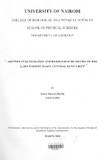| dc.description.abstract | The geology of Nakuru area comprises mainly of volcanic soils and rocks (lava and pyroclastics)
of Tertiary – Quaternary age, which has been affected by a series of faulting, and are overlain by
recent sediments. This study considers groundwater to be the chief source of water for the
expanding agricultural, industrial, domestic and wildlife demands, and thus there are possible
negative effects on groundwater in the basin due to depletion of this resource and deterioration of
its quality. Apart from anthropogenic factors, the geology of the area seems to contain a great
potential to pose a risk to the regional groundwater variably depending on their/its elemental
composition due to their persistent interaction with the water.
The general objective of this study was to relate aquifer stratigraphy and lithology to
groundwater geochemistry and quality by assessing and determining the stratigraphy, lithology
and spatial extent of aquifers present with respect to the possible influence on
hydrogeochemistry. The approaches pursued here include the chemical analyses of major ions
and heavy metals for constructing hydrogeochemical maps with focus on aquifer material and
distribution. A total of 55 deep boreholes, 3 shallow boreholes, 3 springs and 19 river sites were
sampled and water analyses performed for the major ionic composition, together with fluorite
and selected heavy/trace metals. Saturation indices were calculated, ionic relationships were
studied, hydrochemical facies were determined and water types were identified. Driller’s logs
from 33 boreholes were utilized to assess aquifer lithology and hydrogeostratigraphy. The data
was analyzed and in effect interpreted by the help of appropriate computer programs such as
SPSS, WinLog, AquaChem, Rockworks and PHREEQC.
Results indicated that aquifer distribution varies from single to three aquifer systems with three
major aquifer lithologies. These include fissured trachyte, volcanosediments and pyroclastics
revealing a dominant trend in lowlands (<2000m.a.s.l), midlands (2000 – 2200m.a.s.l) and
highlands (>2200m.a.s.l) of the study area, respectively. Lithological logs analyses show aquifer
thickness variation that ranges from 2 to 46 meters. The composition of dissolved ions in the
groundwater is order of HCO3->Cl->SO42->NO3- (anions) and Na+>K+>Ca2+>Mg2+ (cations),
with considerable amounts of some heavy/trace metals (in the order of Zn>Fe>Mn>Pb>Cd>Cr).
The principal processes that control the groundwater quality variations are the influence of
silicate rocks weathering and anthropogenic contribution which is also significant. Most of these
ions surpass local and international recommended limits and areas with lofty values have been
defined. The outcome of this study provides information needed for groundwater quality
budgeting and management. | en |

